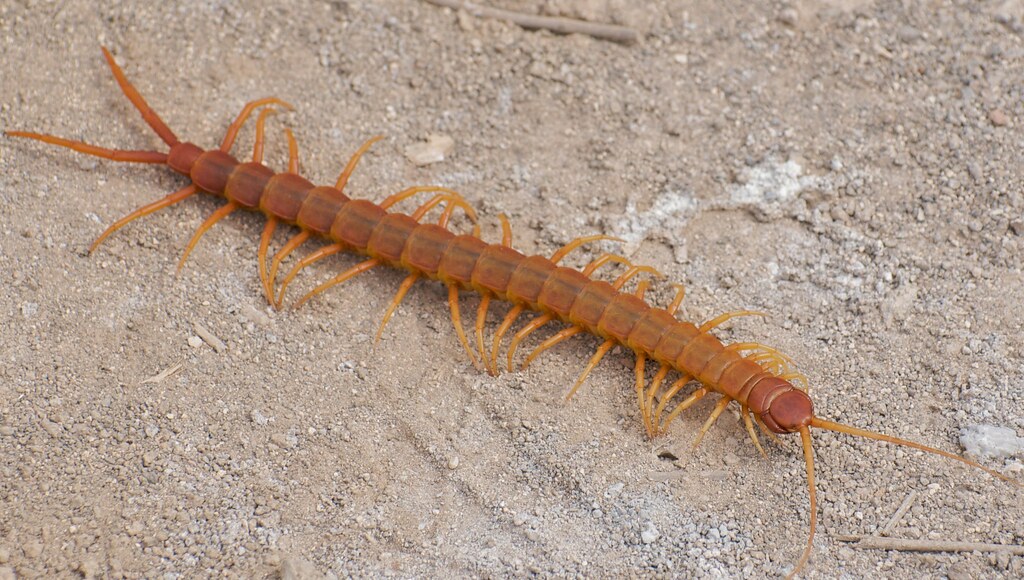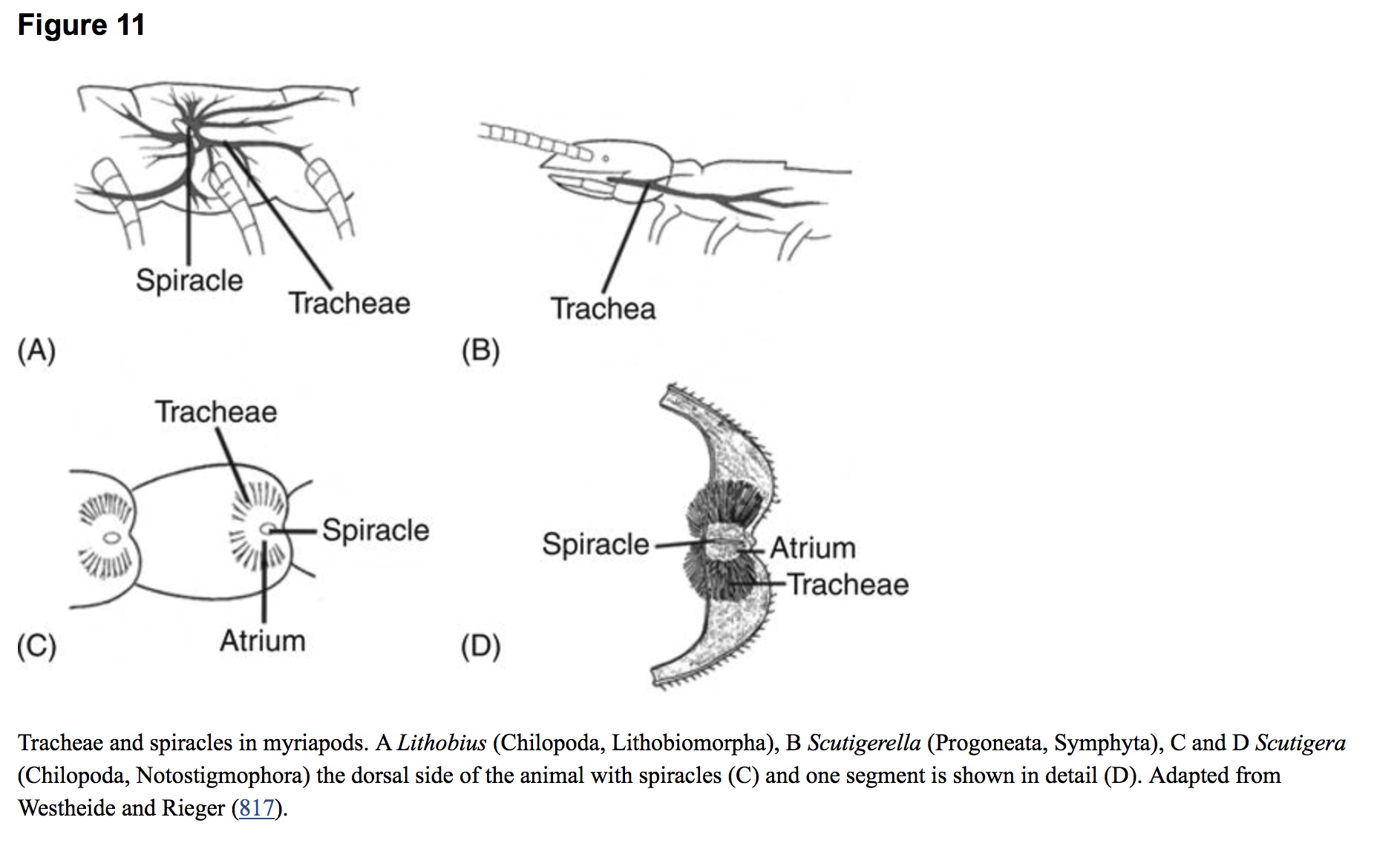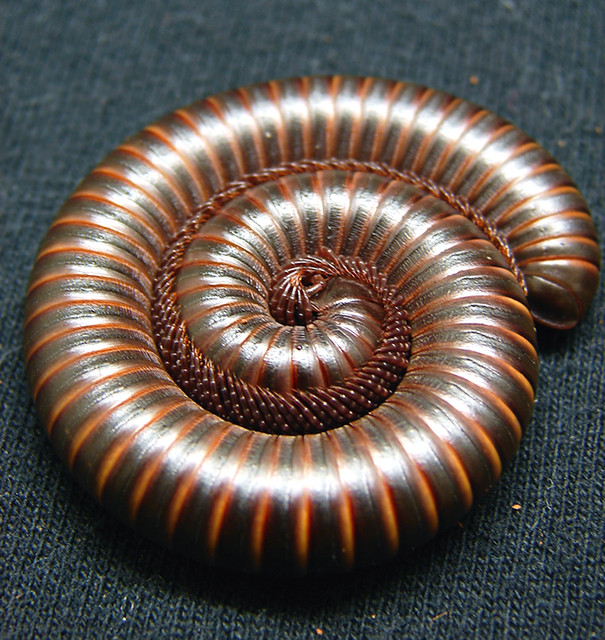Week 10 Blog Post – Myriapoda – Revised 12.1.17
Posted by kflani on December 2, 2017
Filed under Myriapoda
Physiology of Myriapoda
Introduction
This week in Invertebrate Biology, our professor has us identify an organism that many people have encountered before. It may not have been a pleasant experience, but can you guess the identity of this invertebrate?

Kevin Collins, 2008. This is a common house centipede, our unknown invertebrate for the week.
When presented with its picture, I figured the organism had to be an arthropod due to the presence of an exoskeleton. I further determined it was in the subphylum myriapoda by looking at its antennae and multiple feet.
The subphylum myriapoda comprises four orders: chilopoda (centipedes), diplopoda (millipedes), pauropoda, and symphyla1,2.
Of these four orders, I determined the invertebrate was in either in the order chilopoda or diplopoda. To tell the difference between centipedes and millipedes, its important to take a look at their exoskeletons. Centipede exoskeletons – and body segments – are spread apart and are dorsally flattened4. In contrast, millipedes are known to have extremely consolidated and strong exoskeleton that is rounded or cylindrical2.

A. Davey, 2009. Example of a centipede body plan. Notice the flattened appearance in contrast to the millipede below.

Thomas Shahan, 2012. Example of a millipede body plan. Notice the rounded, cylindrical body shape compared to that of the centipede above.
Based on the above information, our invertebrate of interest this week was determined to be an example of a centipede within the order chilopoda; more specifically it is a Scutigera coleoptrata, one of several species of house centipedes3.
Centipede Physiology
If you’ve come across one of these in your house, there’s a good chance the run-in was in a bathroom, the basement, or another humid nook or cranny. This is because centipedes like to be protected – crawling into tight spaces helps with this – and moist3. Where we typically find centipedes plays a large role in their physiology. An animal’s physiology describes the life-supporting – homeostatic – properties, functions, and processes.
The most important threat to centipedes is desiccation, or drying out. This is why we typically find centipedes in damp places – they are essential for survival. This drying out process takes places through respiration and through water loss through the cuticle. Centipede respiration is accomplished by a tracheal system whose outer opening (the spiracle) cannot be closed1. Because these spiracles cannot be closed, air can pass through the spiracles at any time, ensuring desiccation if a more humid environment cannot be found.

Drawn by Kaylyn Flanigan, 2017. Many myriapods – and other organisms – have a tracheal system similar to this. However, the house centipede, S. coleoptrata, has a “lung” or balloon structure off of the spiracle instead of the tube-like trachea.
The tracheal system of S. coleoptrata is unique when compared to the other centipedes. First off, S. coleoptrata has a spiracle that opens into an air sac from which the trachea arise2,5. The air sac is comparable to the shape of a “lung” or a balloon. The ambient air passes through the spiracle into the air sac, then the trachea transfer that air directly to the blood5. The importance of this structure could arise from the habitat which S. coleoptrata inhabit. The habitats are variable in humidity and the “lung” may serve as a barrier to better mitigate desiccation that an open trachea would.This type of respiratory system is also found in some arachnids7.

Hsia, C., 2014. D. on Figure 11 shows what the atrium or “lung” looks like in some organisms. (A) shows the branching of the tracheae from a single spiracle. This increases the surface area and the reach of the tracheae improving gas exchange. (B) shows where the single spiracle is located on the head of Symphylans. (C) shows the location of the spiracles on a specific segment. (D) The atrium is the “lung” which inflates with air from the spiracle and then the air travels through the hair-like trachea. You can see these hairs in the drawing of (D).
While respiration brings air into the organism that can cause it to dry out, being able to retain water also involves a centipede’s morphology. Although centipedes have cuticles, this cuticle lacks a waxy coating which, when present, forms an layer that repels water – in this case, holds it inside the organism6. Centipedes also behave in a way that conserves their body moisture. Many centipedes are nocturnal and move about at night in order to decrease the likelihood of desiccation; similarly, if they are active in the daytime, they have light sensing organs to avoid the harsh light6.
Similarities between classes
In addition to chilopoda, all other classes – diplopoda, symphyla, and pauropoda – greatest stress on homeostasis is desiccation. This concern, like in chilopoda, stems from their respiratory system’s spiracles not being able to close and their lack of a waxy cuticle1,6.
The avoidance of light has been observed in all species2. This includes the blind symphyla and pauropoda. Scientists suggest that, in addition to the simple eyes of some species, there are photoreceptors somewhere else on the body – experiments were conducted with blind myriapods and those how had their eyes experimentally covered6. Myriapods have also been known to travel throughout the soil column based on moisture availability to maintain their water concentration in relation to the ambient humidity.
Many myriapods also possess hemocyanin, a protein that floats in their hemolymph (fluid circulating in their bodies) and binds to oxygen7. By having hemocyanin, their oxygen requirement is lowered because the protein only bind one molecule. This conserves their respiration and could help mitigate factors associated with desiccation.
Differences between classes
Diplopods, millipedes, have more spiracles than compared to other classes – they have two pairs on each segment2. While it was never explicitly stated in the research, it would make sense that more spiracles would lead to more water loss and thus more physiological mechanisms to find humid areas.
While myriapods have the capability to burrow when the ambient humidity is too low, diplopods have a such a tough exoskeleton that may be helpful in burrowing. Similarly, diplopods have the ability to coil their bodies, and while this is usually seen as a prey defense mechanism, it can also prevent water loss2.

Reinbold, M., 2007. The coiling of the millipedes can be a form of protection from both desiccation and predators.
The class symphyla are small centipede-like myriapods that have unique trachea distribution. Dissimilar to other classes, symphylans have a single pair of spiracles on their head which supplies oxygen to their entire body2. While other respiration may happen at the body surface, it is likely that symphylans lose less water through tracheal respiration.
Finally, the class pauropoda has no trachea2! They do respire through the body surface and have spiracles, but they lack the oxygenating tunnels that other myriapods possess.
Works Cited
1 Pechenik, J.A. Biology of the Invertebrates. 7th ed., McGraw Hill Ed., 2013.
2 Meglitsch, P.A. and F.R. Schram. Invertebrate Zoology. 3rd ed., Oxford University Press, 1967.
3 Ricks, Winston. “Scutigera coleoptrata.” Edited by Sara Diamond, Animal Diversity Web, 2001.
4 Ogg, Barb. “Millipedes and Centipedes.” University of Nebraska – Lincoln.
5 Hilken, G., et al. “Interaction of the tracheal tubules of Scutigera coleoptrata (Chilopoda Notostigmophora) with glandular structures of the pericardial septum.” Zookeys, 510: 233-242. 2015.
6 Pearse, V., et al. Living Invertebrates. Blackwell Scientific Publications,1987.
7 Hsia, C., et al. “Evolution of Air Breathing : Oxygen Homeostasis and the Transitions from Water to Land and Sky.” Comparative Physiology 3(2): 849-915. 2014.
